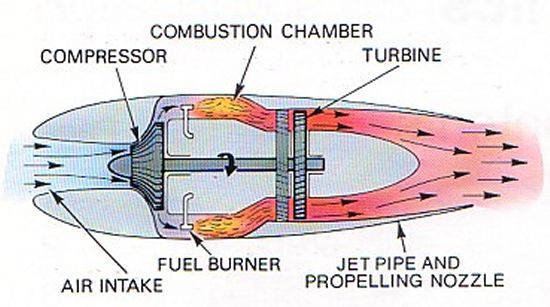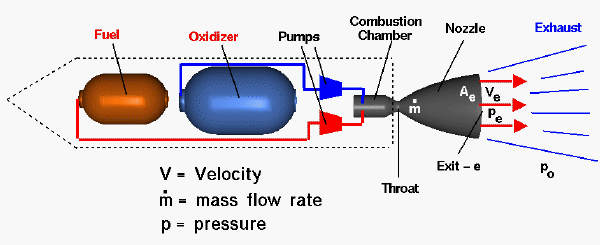What is the difference between a rocket engine to a jet engine?
A jet engine obtains its oxidizer from the external atmosphere, as illustrated in the diagram below. Air enters the engine through an inlet and is then slowed down and compressed by a series of compressor blades. The compressed air is then mixed with fuel, typically a petroleum-based liquid similar to kerosene, and burned.
The high-pressure gas is exhausted through a nozzle to generate thrust.

This class of rocket carries a liquid fuel and a liquid oxidizer in two separate tanks. The two liquids are pumped into a combustion chamber at some rate, called the mass flow rate, where they are mixed and burned. Just as in the jet engine described earlier, this combustion process generates a high-pressure gas that is exhausted through a nozzle to generate thrust.

Developments through the centuries have resulted in two general types of reaction machines, the true rocket and the airstream engine, commonly known as the jet engine. Unlike a jet engine, a rocket engine carries with it chemicals that enable it to burn its fuel without drawing air from an outside source. Thus a rocket can operate in outer space, where there is no atmosphere.
Rocket creates thrust by expelling combusted fuel out the back of an opening in the tank or fuel container. The thrust is created by the chemical reaction you might call an explosion. A jet engine uses fans and multiple levels of chambers to compress air which it sucks in the front and blows out the back with greater force.
A jet engine sucks oxygen from the air and combusts it with fuel carried in a tank. A rocket engine carries both fuel and oxygen in separate supply tanks and does not require an external oxygen source. For this reason jet engines can only operate inside the Earth's atmosphere, whereas rocket engines can operate outside of the atmosphere.
The biggest difference between a jet engine and a rocket lies in their propulsion systems. A jet engine combines oxygen from the air with fuel at high temperature. There is usually a spark to ignite the fuel vapor, but once the engine begins turning, it will continue running until it runs out of fuel or air.
The jet is pushed forward by the hot gas coming out the back, the same way a garden hose pushes back on you when you spray it. The rocket engine, by comparison, is not what's called an 'air-breather'. Rockets can work anywhere, in vacuums, or in the atmosphere.
A good example of this would be the space shuttle, which uses both of main types of rocket engines. The large nozzles you see at the bottom of the Shuttle itself and liquid-fueled rocket motors. They spray liquid hydrogen and liquid oxygen together, right at the bottom of the cone, which then burns as long as it continues to be fed fuel and oxygen.
The rocket, however, doesn't use any air. It will work at any altitude, or in space. The problem is, though, that now, the craft must not only carry fuel... but it must carry oxygen as well.
The huge brown tank on the belly of the Space Shuttle is the main fuel tank, holding both hydrogen and oxygen. To lift all that weight requires a LOT of energy, which requires more fuel, which requires more space, and weight; and at a certain point, using liquid-fueled rockets, you start to work against yourself. You can see how large the Saturn V rockets were compared to the Space Shuttle, and you can compare payloads.
This is where the solid rocket boosters come in. The long, relatively thin rockets flanking the Space Shuttle are solid rocket boosters. The solid rocket boosters are filled with aluminum oxide powder.
There is a small section of starter material in the bottom of get them started, and once they get started, that's it. Therein lies the most gigantic problem of solid rockets... they can't be shut off. The solid boosters have more power than the liquid engines, they weigh less, they are much much much more reliable, but they can't be shut off.
If they could, the Challenger wouldn't have gone down. So there it is, in a nutshell. Jet engines mix air and fuel, and burn it to propel themselves, liquid rockets mix fuel and oxygen, and have to carry both all by themselves.
Solid rockets carry all their fuel internally, and are light, but they can't be stopped once they are started. I hope that answers everything for you. http://www.physlink.com/education/askexperts/ae529.cfm.
I cant really gove you an answer,but what I can give you is a way to a solution, that is you have to find the anglde that you relate to or peaks your interest. A good paper is one that people get drawn into because it reaches them ln some way.As for me WW11 to me, I think of the holocaust and the effect it had on the survivors, their families and those who stood by and did nothing until it was too late.
Related Questions
Bubble Jet 2000 is the setting solution, right?" Bubble Jet Rinse may be a misnomer, Bubble Jet Rinse really is a?
What is the Difference between engine powered airplane and jet airplane?
You made a big deal earlier about "D-jet" and "L-jet" FI systems. What are they?
How do Bubble Jet Set and Bubble Jet Rinse work and what fabrics should I use?
Steel melts at 2750 degrees. Jet fuel burns at 1400 degrees. How can jet fuel ignite steel beams?
What is the difference between a dot matrix and a ink-jet printer?
